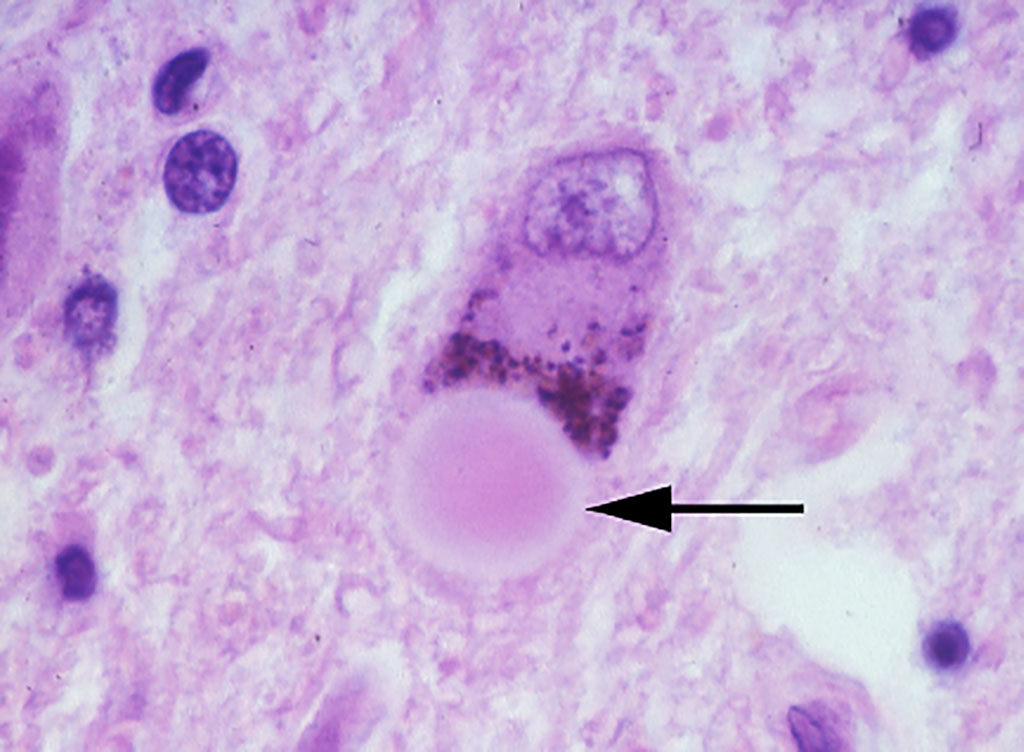Five Genes Help Predict Lewy Body Dementia
By LabMedica International staff writers
Posted on 10 Mar 2021
Lewy body dementia usually affects people over 65 years old. Early signs of the disease include hallucinations, mood swings, and problems with thinking, movements, and sleep. Patients who initially have cognitive and behavioral problems are usually diagnosed as having dementia with Lewy bodies, but are sometimes mistakenly diagnosed with Alzheimer’s disease.Posted on 10 Mar 2021
Many patients that are initially diagnosed with Parkinson ’s disease may eventually have difficulties with thinking and mood caused by Lewy body dementia. In both cases, as the disease worsens, patients become severely disabled and may die within eight years of diagnosis. A growing body of evidence suggests genetics may play a role in the disorder and that some cases may be inherited.

Image: Histopathology of Lewy bodies in the midbrain. A Lewy body in a melanized neuron from the substantia nigra. The Lewy body is the spherical body indicated by an arrow (Photo courtesy of Dr. Susan Daniel).
A large international team of scientists led by those at the National Institute of Neurological Disorders and Stroke (Bethesda, MD, USA) compared the chromosomal DNA sequences of 2,981 Lewy body dementia patients with those of 4,931 healthy, age-matched control participants. Samples were collected from participants of European ancestry at 44 sites: 17 in Europe and 27 across North America.
The team found that the sequences of five genes from the Lewy body dementia patients were often different from those of the controls, suggesting that these genes may be important. It was the first time that two of the genes, called BIN1 and TMEM175, had been implicated in the disease. These genes may also have ties to Alzheimer’s and Parkinson’s diseases. The other three genes, SNCA, APOE, and GBA, had been implicated in previous studies, and thus, strengthened the importance of the genes in Lewy body dementia. They also saw differences in the same five genes when they compared the DNA sequences of another 970 Lewy body dementia patients with a new set of 8,928 control subjects, confirming their initial results.
Further analysis suggested that changes in the activity of these genes may lead to dementia and that the GBA gene may have a particularly strong influence on the disease. The gene encodes instructions for beta-glucosylceramidase, a protein that helps a cell’s recycling system break down sugary fats. The team found that both common and rare variants in the GBA gene are tied to Lewy body dementia. They also found that the genetic profiles of the patients in this study had higher chances of suffering from either Alzheimer’s or Parkinson’s disease than the age-matched control subjects.
Sonja W. Scholz, MD, PhD, a Neurologist and the senior author of the study, said, “Although Alzheimer’s and Parkinson’s disease are molecularly and clinically very different disorders, our results support the idea that the problems that cause those diseases may also happen in Lewy body dementia. The challenge we face in treating these patients is determining which specific problems are causing the dementia. We hope studies like this one will help doctors find precise treatments for each patient’s condition.” The study was published on February 15, 2021 in the journal Nature Genetics.
Related Links:
National Institute of Neurological Disorders and Stroke













